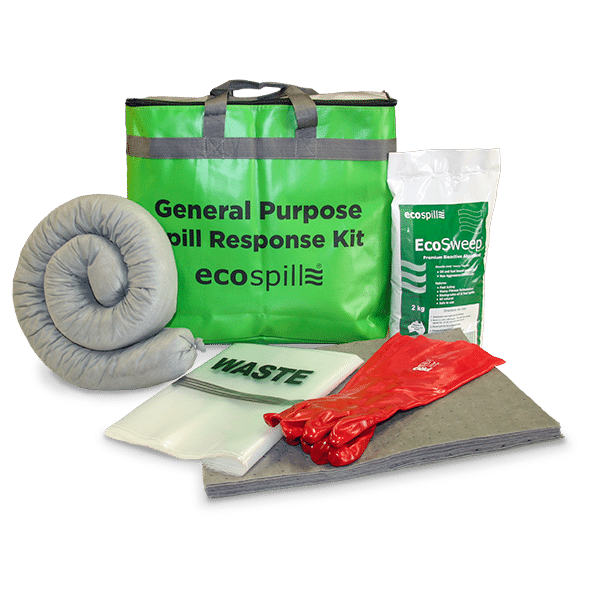What Is In A Basic Spill Kit

Keeping an organised and tidy workplace can improve health and safety. Ensuring your staff have the appropriate training to perform their tasks safely can also reduce workplace risks. Using best practices in your workplace doesn’t eliminate all risks, though. If you’re working with chemicals or oils, preparation for when an accident occurs can be a necessary step in protecting you and your staff.
Chemicals can cause harm to people and the environment. So when they spill, it can be concerning. Spill kits can be the answer to that problem. Health and safety are maximised when response time and appropriate containment measures are optimised. Familiarising yourself with spill kits can mean you’re well prepared. In this article, we outline what is in a basic spill kit.
GENERAL PURPOSE SPILL KITS
Spill kits are a packaged group of equipment to contain and clean chemical spills. They can be an excellent resource to minimise the damage caused and wastage when liquids are spilt. Spill kits provide everything you need in one transportable location, making clean up fast and efficient. It also means your staff can know how to act and where to find the spill equipment quickly.
As the name suggests, you can use general-purpose spill kits for all liquids and chemicals. Their materials are designed to clean up any fuel, oil, and non-aggressive chemical spills, such as coolants and agricultural chemicals.
WHAT ARE THE CONTENTS OF A BASIC OF GENERAL PURPOSE SPILL KIT
In emergencies, it can be important to be familiar with what is included in a basic spill kit so you can act fast. Below are the necessary pieces of equipment to contain and clean up a spill.
Spill absorbent product
An absorbent product is for soaking up the liquid that’s been spilt and minimising the hazard area. They usually come as a powder that you can spread on the spill. The powder can absorb the liquid and stop it from spreading and make it easier to clean up.
Containment booms
Your spill kit should include a containment boom or land sock. Containing a spill is essential to ensure that it doesn’t travel. Containment booms can be placed around the perimeter of the spilt liquid to secure the area. This allows your hazard area to be stationary and can make for a more efficient clean up.
General-purpose absorbent mats
General-purpose absorbent mats work to collect the chemical and remove it from the spill area. Absorbent mats directly soak up the liquid into the mat, a bit like a sponge, so it can then be disposed of. They’re an essential part of the cleaning process as they physically remove the chemical from the spill area.
Personal protective equipment
PPE (personal protective equipment) is the safety clothing that your staff wear to protect them from hazards. When your team is cleaning up a chemical spill, they’re at a greater risk of harm. It’s likely that they will get close to the chemical and even come into contact with it. Many chemicals are hazardous or corrosive and can cause severe injuries to people. The PPE in a general-purpose spill kit can include long PVC gloves, safety glasses and disposal overalls for full-body protection.
Antistatic waste disposal bags with ties
Antistatic waste disposal bags are responsible for the safe disposal of the spilt chemical and the materials involved in its clean up. The chemical must be separated from other waste, so it doesn’t contaminate the wastage. Placing the spilt chemical and clean-up materials into the waste disposal bags provides containment so they can be disposed of safely. To ensure that the contents don’t spill out of the bags, they come with ties to secure them.
Spill response clean-up instructions
General-purpose spill kits should come with their spill response clean-up instructions. Spill kits can vary in their specific materials and the sequence they are used in. When a spill has happened in your workplace, response time can be vital to minimising harm. Your staff can refer to the step-by-step instructions to learn exactly how to respond to the spill.
SUMMARY
Before you purchase a spill kit, check its contents to make sure it’s suitable for your needs. Identifying the chemicals you use in your workplace can help you decide on the right spill kit. A general-purpose spill kit can be the best option if you deal with different non-aggressive substances and oils. If you handle aggressive chemicals, then a more specific chemical spill kit may be better. They should include the items mentioned in this article for safe and fast spill response.
The size of the spills can also be important when choosing your spill kit. Larger spill kits can suit higher volume spills from crane machinery and trucks, for example. For smaller work areas, a 20L spill kit may suit your needs to manage the associated spills. Spill kits can be an essential part of any workplace that deals with liquids. After you’ve identified the needs for your workplace, you may be ready to stock up and get prepared.
